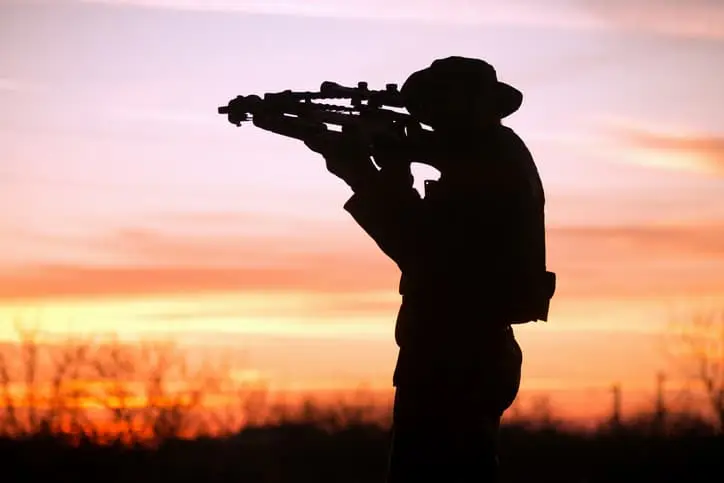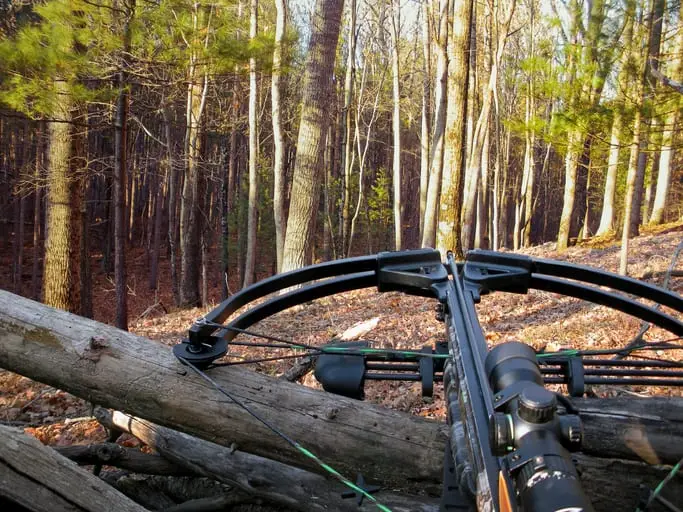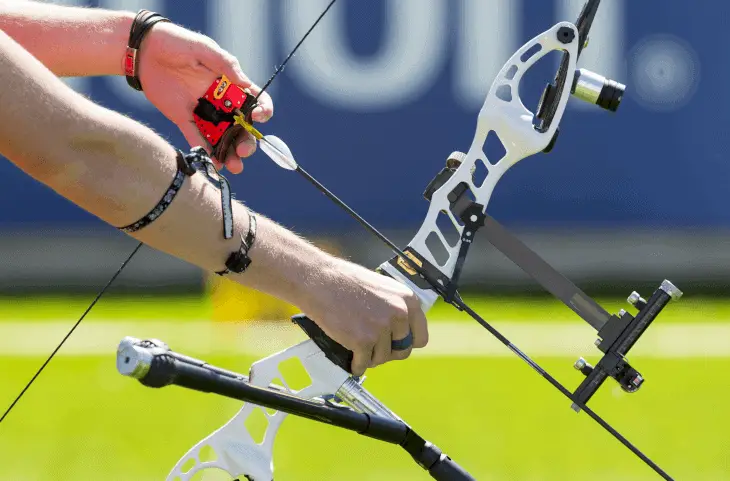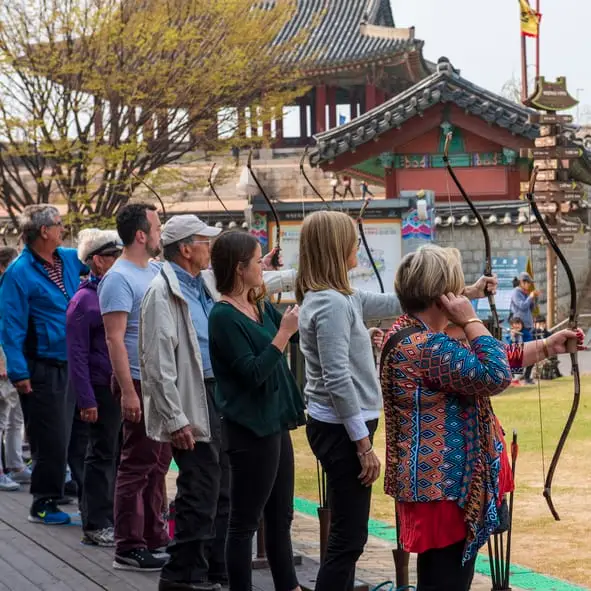
So, How far can a crossbow shoot? Well, A modern crossbow firing at 400 FPS can shoot a bolt almost 5,000 feet if shot at a 45-degree angle. If the crossbow is perfectly level, it can shoot about 240 feet. To understand why these numbers are so different, you have to understand the factors that affect crossbow range and math that goes along with it.
The Evolution of Crossbows

Ancient China
Crossbows were first invented in China over 2,500 years ago. In fact, they are mentioned in Sun Tzu’s The Art of War written sometime between 500 and 300 BC. During the Han dynasty, up to half of Chinese armies consisted of crossbowmen. Military commanders and theorists of the time admitted the crossbow’s slow rate of fire but still preferred them specifically for their range. The armies used massive, mounted crossbows for sieges and defending mountainous terrain, and these had ranges recorded as up to 2,500 paces, probably over 1,000 meters, more than half a mile. Handheld crossbows had lower ranges, but it’s still estimated they could reach nearly 450 meters, about 1,500 feet.
Classical Europe
A crossbow-like weapon called the gastraphetes first appeared in Europe a short time later around 420 BC, but few artifacts remain. These weapons were employed by Greece and later Rome as handheld crossbows and large mounted siege weapons, but after the fall of the Roman Empire, they seem to have fallen out of use. Reconstructions from diagrams estimate the crossbow range of the gastraphetes at about 230 meters, around 750 feet.
The Medieval Period
Crossbows aren’t seen again in the historical record until around the 10th Century when Medieval France began using them extensively. During the Medieval period, the crossbow gained in popularity until it became the primary range weapon of the day. Crossbowmen were coveted soldiers, and armies used whole crossbow teams to defend fortresses and castles. Originally made entirely of wood, technology improved throughout the period until strong steel laths were commonplace and increased the maximum range. In fact, crossbow ranges by the late 14th Century exceeded 400 meters or 1,300 feet.
Modern Crossbows

The end of the Medieval Period also saw the end of the crossbow as a military weapon. The invention of firearms made them obsolete for combat. That doesn’t mean they’ve disappeared, though. In fact, crossbows have seen a modern revival, especially for hunting and target shooting, but they’re also used by some police and paramilitary forces. Crossbows are often quieter than firearms and come with fewer regulations.
Thanks to improved manufacturing technology, the modern crossbow range is even better than its military-grade Medieval predecessors. The best crossbows can shoot well over 1,000 yards if all you care about is distance. Of course, this number can be affected considerably by outside factors.
Effective Crossbow Range
Just because you can shoot your crossbow nearly 3,000 feet doesn’t mean that will do you a lot of practical good. It’s much harder to shoot a crossbow accurately at long range. In fact, the record accurate crossbow shot is 200 yards, less than a fifth of the theoretical maximum crossbow range.
This was done by a Tom Smith, though, a professional archer. For the average hunter or hobbyist, shooting accurately at even 200 yards is out of the question. Instead, the effective crossbow range for most people is going to be about 40 yards increasing to a maximum of 60 yards for expert crossbowmen with quality crossbows.
Within this range, an amateur archer with a sighted-in bow can consistently make an accurate shot. For hunting, this means hitting the kill zone. The kill zone on a whitetail deer, for example, is a circle about 10 inches in diameter over the animal’s heart. When you’re outside of that effective range of 40-60 yards, the chance of hitting the animal outside of this zone increases dramatically. Not only would that mean you go home empty handed, but it’s unethical because you may severely wound the animal without killing it.
Factors Affecting Crossbow Range
Bolt Speed
The factor that most affects how far your crossbow can shoot is how fast it can fire the bolt. In fact, most of the other factors are only factors at all because they change the bolt speed. To understand why this is so important, you have to dust off your high school physics knowledge.
As Galileo discovered in the 16th Century, all objects on Earth from a 1,000-ton meteor to a one-ounce marble are affected the same by gravity and fall at the same rate. Specifically, gravity causes all bodies to accelerate at a rate of 9.8 meters per second squared. This results in the following equation that you can use to determine how long it will take an object to fall a certain distance.
G is the acceleration caused by gravity, which we can round up to a simpler 10. D is the distance the object has to fall. If you’re shooting a crossbow, that distance is going to be roughly your height. To make it easy, let’s pretend you’re 2 meters tall. Do the math, and you’ll see that it only takes about 0.6 seconds for that bolt to hit the ground. Not very long at all. Even if you can add 5 meters of tree stand below you, it will only take 1.2 seconds.
Now, just because a bolt is moving horizontally, that doesn’t mean it will fall any less quickly. If you drop a bolt from your hand at the same time you shoot one from a crossbow, they’ll hit the ground at the exact same time. This means that the faster the bolt, the farther it can get in that short amount of time.
Unlike vertical bows, bolt speed on crossbows is very consistent. That’s because little changes between shots. Every time you shoot a crossbow, you draw the bowstring to the same point using the same amount of force, thereby storing the same amount of energy in the limbs. Therefore, if the manufacturer says your crossbow fires at 400 FPS (feet per second), then it probably does—as long as you use their bolts.
If your crossbow does indeed shoot its bolts at 400 FPS, then you can figure out how far it will shoot in a straight line based on the math above. The bolt goes 400 feet every second but only has 0.6 seconds in the air. Multiply them together, and you find that your bolt will go 240 feet.
Bolt Weight
As mentioned before, a crossbow’s speed rating is based on a specific bolt, usually the one sold by the same manufacturer. Using a lighter or heavier bolt will change the bolt speed from the listed rating and therefore change the range. To see why, take a look at the formula for kinetic energy:
The m stands for mass and the v for velocity. The Ek refers to kinetic energy. Whenever you draw your crossbow, you use a certain amount of energy, most of which gets stored in the limbs and bowstring. When you release the trigger, that energy is transferred to the bolt, making it fly. Plug in a couple of simple numbers, and you’ll see that if the kinetic energy is the same, more mass will mean less velocity and vice versa.
Specifically, every 10 grains of weight will change your bolt speed about 3 FPS. If you didn’t know, grains are the unit of measurement usually used for arrows and bolts. One grain is about 65 milligrams. Heavier bolts mean lower FPS and therefore lower range.
Draw Weight/Pull and Length
Crossbows usually don’t have adjustable draw weights or lengths, but there are exceptions. Plus, some crossbowmen alter their own crossbows by loosening or tightening the limbs, even though this is unadvisable and potentially dangerous as the limbs may then snap under tension.
As a rule of thumb, changing the draw weight up or down by five pounds will change your bolt speed by 8 FPS. Higher draw weights mean faster bolts and therefore longer range. Draw lengths can also change FPS, but that’s because they change draw weights. Long draw lengths mean more draw weight and vice versa. In fact, most adjustable crossbows change draw weight by changing the draw length, so for calculation purposes, it’s easier to just focus on draw weight.
Arc and Angle
As you saw from the math above, a bolt does not have long in the air before it hits the ground. Consequently, the best way to maximize crossbow range is to increase the amount of time the bolt is in flight. Imagine you shoot the bolt straight up. It will be in the air for a long time, but it will also come back down in the exact same place.
Intuitively then, you can increase the flight time and maximize forward distance at an angle halfway between horizontal and vertical, in other words, 45 degrees. The math also proves this. The equation for distance involving angles is:
If you remember trigonometry, the sine function goes up and down. It peaks at sin(90), meaning that the equation maxes out when 𝜭 is 45. In fact, this makes things much simpler by reducing the equation to:
However, this assumes a perfect arc. That’s fine if you’re shooting a target roughly your height, but we want the maximum distance before hitting the ground. Since you’re probably shooting from a standing position or maybe even a tree stand, the bolt has to drop farther than it rises. The math for figuring out the range in this case is considerably more complicated, but it works out to this formula:
In this formula, y0 is the initial height you shot the bolt from. Once again, 45 degrees is the angle that maximizes distance. Any deviation from 45 whether up or down will change the range the same amount. For example, shooting from both 30 and 60 degrees results in more or less the same distance.
Calculating Max Crossbow Range
You can easily use the equations above to figure out the maximum range of your own crossbow. Let’s say your model is rated for 400 FPS and you’re shooting from a height of about 6 feet. Convert those to meters for a speed of 122 meters per second and a height of 1.8 meters and use the gravitational constant g of 9.8 meters per second squared. Make 𝜭 45 degrees for maximum range. Plug it all in to the formula:
You get roughly 1,500 meters, nearly 5,000 feet or almost a mile.
If you want to know the straight-line range of your crossbow, you can use the same formula and plug in 0 for all the angles. That actually simplifies it to a much easier formula:
d=v2gy0g
Plug in the same numbers, and you get a range of 74 meters, just barely 240 feet, same as we found before.



